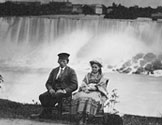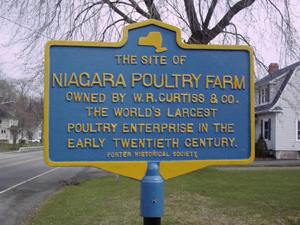

|
||||||||||||||||||||||||||||||||||||||||||
|
| ||||||||||||||||||||||||||||||||||||||||||
 |
 |
 |
 |
 The Niagara Poultry Farm of Ransomville  The hamlet of Ransomville was named for the Ransom family who settled there in the 1830s. Years earlier however, the Curtiss family had cut their way through the wilderness to become the first settlers in the hamlet. Gideon and Captain Gilbert Curtiss, arrived in the area before 1820. (It is believed that at a meeting to name the hamlet, the Ransoms outnumbered the Cutisses – some people still believe it should have been named Curtissville). The brothers led the way in cutting the road between Youngstown and their new settlement (Rt. 93) and the road between the ridge (Rt. 104) and the lake (now Ransomville Road). Gideon built the first log tavern there in 1817 located just south of the intersection on present day Ransomville Road. Eight years later Gilbert Curtiss opened another log tavern on the north side of Youngstown Road near where the R.W.O. (“Hojack”) Railroad would be built later. In 1840, that tavern was replaced by the larger and more comfortable Ransomville House. The Curtiss’s also bought land east of the intersection and began to build large warehouses for the storage of agricultural products. The “Excelsior Elevator” was built in 1877 right next to the railroad tracks and could hold 25,000 bushels of grain. These enterprising brothers and their descendents would remain prominent in the agri-business for well into the 20th century. In the 1880s, Warren A. Curtiss, son of Gilbert W. Curtiss, took over his father’s grain business and added some chickens to the farm. While still a youth, his son, Ward Roy Curtiss, became very interested in raising poultry for profit. With his father’s assistance, young Ward began his business. He would get up at 2 a.m. and collect eggs to take to markets in Niagara Falls, thirteen miles away. Two years later his older brother, Warren J. Curtiss, became a partner in the business. Over the next thirty years, the poultry farm was expanded to 65 acres directly across from the R.W. O. Railroad depot, an ideal location for shipping eggs to far-off areas. At the height of the business, the farm included seven large incubator buildings capable of holding 100,000 eggs, 200 chicken houses, heated brooder houses, an elevator containing 10,000 bushels of grain and several storehouses. Two of those structures, one incubator and one brooder house, were the biggest in the world at that time. At the turn-of-the-20th century, it was estimated that 100,000 eggs were worth $10,000. By the 1920s the Curtiss family operated one of the largest poultry farms in the world. Farmers from all over the world came to study the methods used by the Curtiss’s. Later in the 20th century, another generation, Rex Curtiss, Ward’s son, began raising ducks and turkeys in addition to chickens. Gradually, as even larger poultry farms were established, the Curtiss farm’s prominence began to wane and the operation shut down in the late 20th century, after more than one hundred years of business. Several buildings and an historic marker still stand to attest to the fact that Ransomville was once the poultry capital of the world. Douglas Farley, Director Ann Marie Linnabery Erie Canal Discover Center 24 Church St. Lockport NY 14094 716.439.0431 CanalDiscovery@aol.com www.NiagaraHistory.org |
|